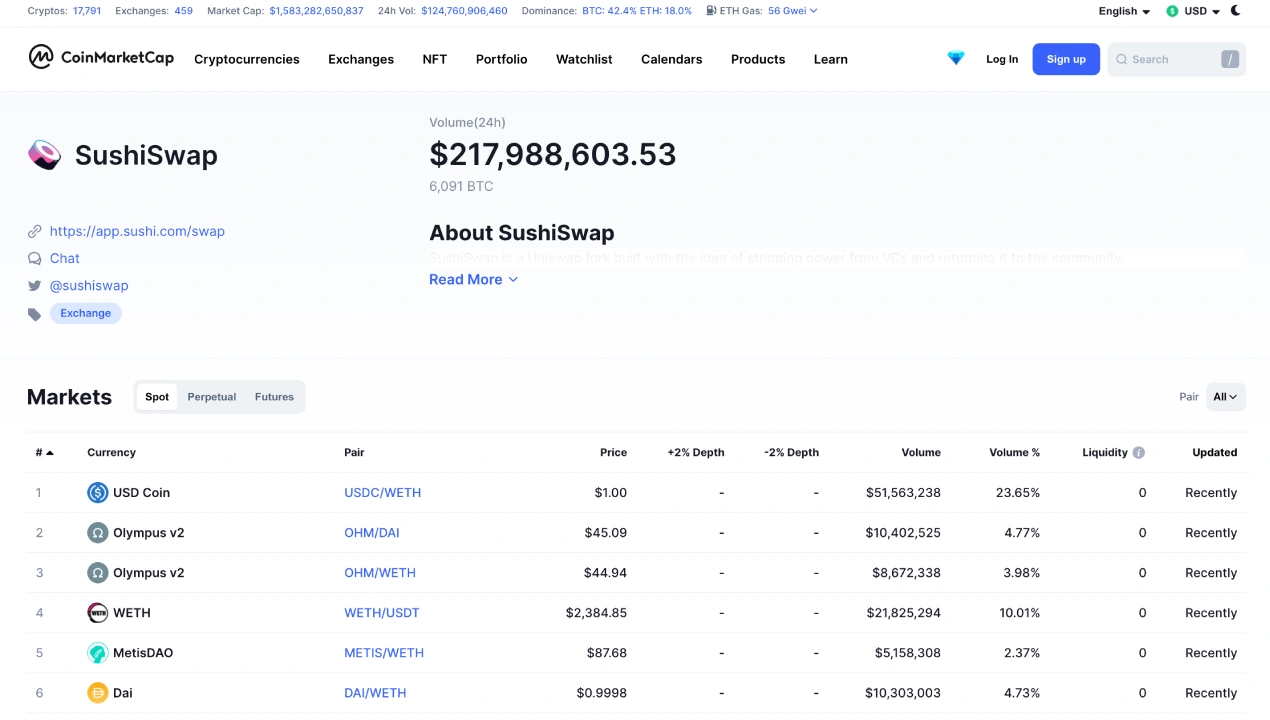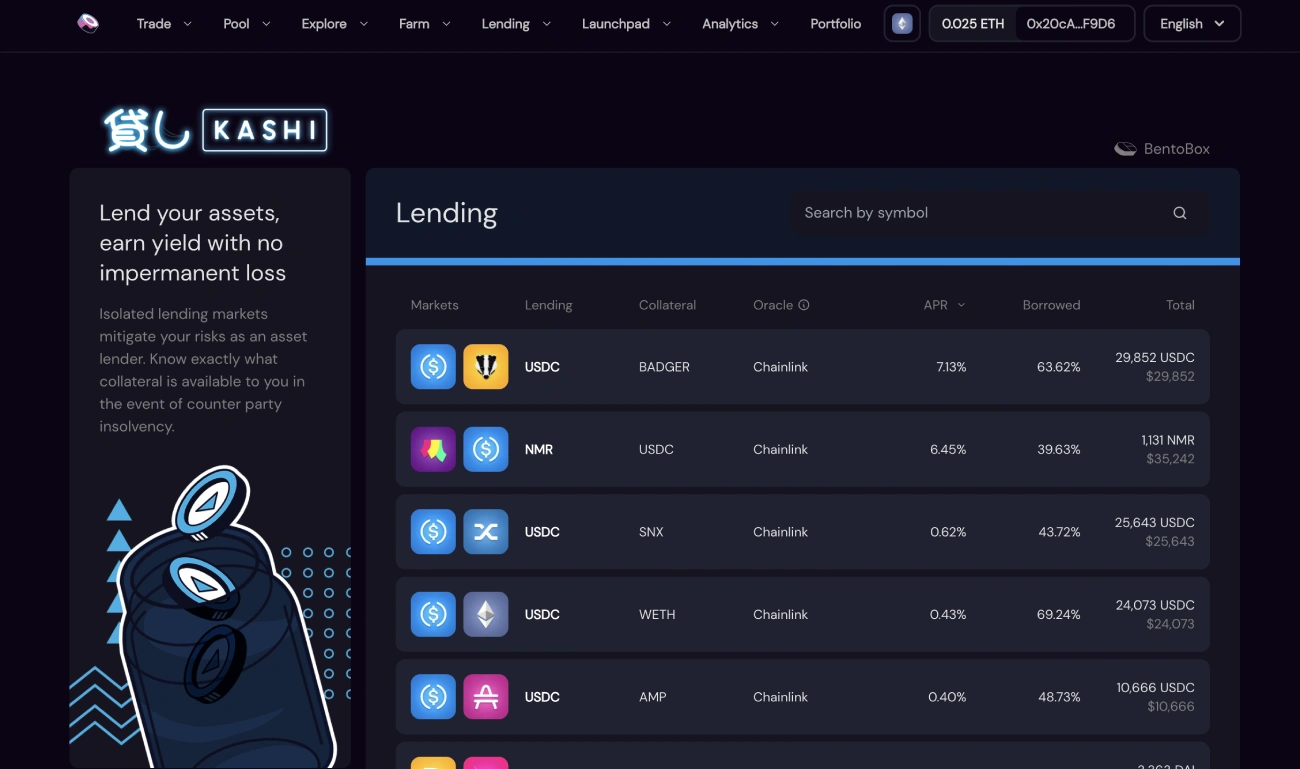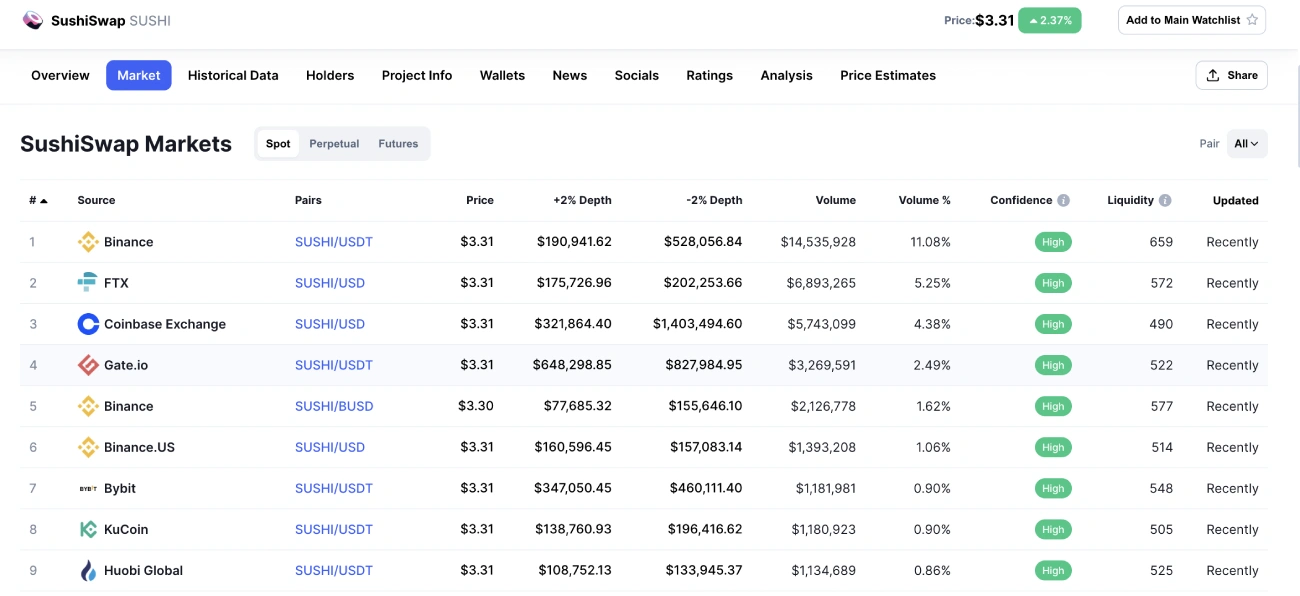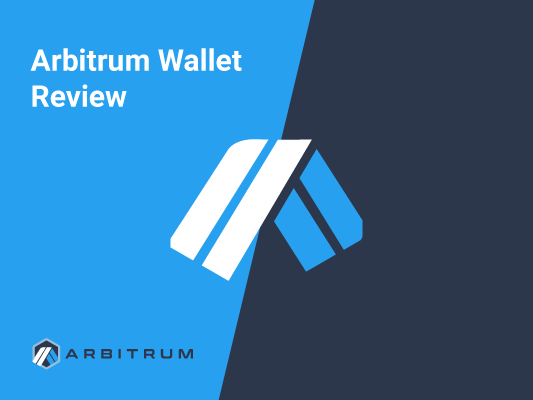
The Ultimate Sushiswap Review [For 2023]
Sushiswap Pros and Cons
Sushiswap Pros
- Availability of 100+ ERC-20 tokens
- Multiple ways to generate passive income
- Largest decentralized exchange in terms of liquidity
- Affordable trading fees
- Top-notch user interface and user experience
Sushiswap Cons
- Unavailability of fiat payment gateways
- Complex to navigate for novices
- Higher gas fees compared to many centralized exchanges
- No constant innovation
The worldwide adoption of cryptocurrencies and blockchain technology has brought a sweeping change in the global financial system. DeFi (decentralized finance) is one of the biggest trends in the blockchain industry, and many believe it will overtake the traditional finance world. DeFi uses DApps and distributed ledger technology (DLT) to allow for permissionless financial operations like efficient stablecoin trading, decentralized lending or Yield Farming, DeFi insurance, liquidity mining, and DEX (Decentralized exchanges) to be conducted within a peer-to-peer network.
DEXs are a key component of the existing DeFi environment, and it won’t even be exaggerating to say that there won’t be DeFi without the existence of DEXs. Choosing the DEX to suit your needs among a staggering number of cryptocurrency exchanges in the market doesn’t seem easy.
Our SushiSwap review will reveal everything you need to know about the SushiSwap exchange, its features, services, trading fees, etc., to help you decide if it’s a suitable exchange for you. SushiSwap is a popular Ethereum-based decentralized exchange (DEX) called an automated market maker (AMM) that allows users to swap tokens, earn rewards via yield farming, and more. It’s a fork of Uniswap, with variations and additional features, the most notable of which is the SUSHI token.
Let’s take a closer look at what you can expect from the SushiSwap trading platform!
What Is SushiSwap
SushiSwap is one of the most popular DEXs in the market. Built on the Ethereum blockchain, it functions as an automated market maker (AMM) technology currently employed by many popular DEXs worldwide.
With SushiSwap, users can trade, stake, and swap hundreds of cryptocurrency tokens in a completely decentralized environment. Unlike many well-known exchanges like Binance and Coinbase, trades on SushiSwap are not controlled or managed by any central authority. Instead, the system automatically sets the real-time prices of crypto pairs using mathematical formulas, and smart contracts settle the trades.
To solve the liquidity problem faced by many centralized exchanges, SushiSwap uses liquidity pools. They are nothing but a large pool of funds created within the SuhsiSwap ecosystem where users lend or stake their crypto to gain interest, rewards, etc.
SushiSwap supports over a hundred altcoins, 480+ crypto swapping pairs, enjoys over $100 million daily trading volume, and has a whopping $5.1 billion in TVL (Total Value Locked).
Brief History
SushiSwap is a fork of Uniswap. It’s based on AMM, ensuring that assets are priced using a trading algorithm rather than an order book used in traditional exchanges.
Both founders of SushiSwap — Chef Nomi and 0xMaki continue to stay anonymous to this day. Chef Nomi was the core developer who created SushiSwap by performing a hard fork on Uniswap’s open-source code in August 2020.
SushiSwap founders and the team took a unique and effective approach to promote their decentralized exchange. Initially, they applied a “vampire mining” scheme using the Uniswap liquidity provider tokens (LP tokens) issued to users who provide liquidity to the Uniswap pools. SushiSwap rewarded their native utility token SUSHI to the liquidity providers on Uniswap for staking their LP tokens on the SushiSwap protocol instead. After a couple of weeks, the staked tokens were migrated to the SushiSwap native pools, and the LP tokens were then exchanged for the original assets put into the Uniswap liquidity pools, thereby creating liquidity for SushiSwap.
SushiSwap has some advanced DeFi functions compared to UniSwap, most importantly its SUSHI tokens, listed on many prominent centralized exchanges like Binance, Coinbase, etc.
How Does SushiSwap Work
SushiSwap aims to facilitate decentralized cryptocurrency trading. Unlike a typical crypto exchange, you don’t need to create an account on SushiSwap to start using their services. All you need to do is connect a web 3.0 wallet compatible with the Ethereum Network.
SushiSwap is equipped with many liquidity pools for different altcoins they support. Each pool consists of two crypto assets, and users can stake one or both assets in the pool to receive rewards in the form of interests and trading fees generated.
For instance, in the AAVE/DAI liquidity pool, you can stake AAVE, DAI, or both to earn rewards.

To get started with SushiSwap, you must hold Ether (ETH) in the first place. Acquiring ETH through fiat currency is possible on any reliable centralized crypto exchange. This can’t be done on SushiSwap because it doesn’t support fiat. Once you have ETH in your crypto wallet, you can start using SushiSwap. After getting the Sushi App, connect any of your web 3.0 wallets like MetaMask to get started. Some of the compatible wallets can be seen in the screenshot below.

Then, on the SushiSwap platform, select your preferred liquidity pool and invest your tokens or coins in starting earning rewards. It’s crucial to perform due diligence before investing in any projects on SushiSwap, as there’s no mandatory verification for projects to get listed on the platform.
Supported Cryptocurrencies
SushiSwap supports over 100 altcoins and 500 crypto pairs. Most of these altcoins are paired with various stablecoins such as USDC, USDT, DAI, etc., or other popular DEX-friendly cryptos like Wrapped ETH (WETH).

Key Features of SushiSwap
If you are a user of Uniswap, you’d be surprised to see how similar both platforms are, as they share the same source code, blockchain (Ethereum), and even the UI and UX. However, the functioning of SushiSwap’s liquidity protocols is more advanced and offers additional convenience.
One primary thing that differentiates SushiSwap is the usage of their native token, SUSHI, which we will discuss in the upcoming sections.
Some of the key features of SushiSwap include:
Swap – The SushiSwap Exchange
As mentioned, you can easily swap your ERC-20 tokens on the SushiSwap Exchange. The platform supports over 100 Ethereum based tokens, and you don’t need to go through any KYC verification to get started.
With a decentralized wallet like MetaMask and some Ether to pay gas fees, you are all set for your swaps on the SushiSwap platform.

Pool – SushiSwap Liquidity Pools
You can become a liquidity provider to SushiSwap pools by staking your cryptos on various liquidity pools available on the platform. As a liquidity provider, you are entitled to receive 0.25% from all the trading fees from the trades that happen in your pool proportional to your share in the pool. You can provide liquidity by depositing equal proportions of both tokens in any existing pool, or you can create your own pool. In doing so, you can also earn SushiSwap liquidity pool tokens (SLP) which have various other use cases within the platform.
Farm – SushiSwap Farming
With SLP tokens, users can benefit from the platform’s yield farming functionality to earn attractive interests. After staking your SLP tokens, SUSHI token farming can be initiated.
Apart from staking SLP tokens, the platform allows various farming opportunities, and each of the farms comes with different APYs and risk levels. As you can see in the above screenshot, the USDC/WETH farm has the highest TVL and yields about 10.5% APY.
Lend – Lending of Cryptos
The lending and borrowing of cryptos on SushiSwap are powered by the platform’s native Kashi trading portal built on BentoBox. Users can create customized markets for borrowing and lending various altcoins, stable coins, and even synthetic crypto assets on this platform. Each money market is kept separately and functions independently on the Kashi trading platform. Contrary to conventional DeFi markets where volatile assets affect the entire protocol, on Kashi, the risk from volatile assets in one lending market does not impact or affect any other money markets.
As shown in the below screenshot, there are various lending markets on SushiSwap where you can lend your tokens and receive high interest.

Borrow – Borrowing of Cryptos
You can also borrow cryptos on the platform by providing collateral. You can borrow assets for minimal interest and gain profit through trading or offering liquidity for higher APRs.

Stake – Staking
On the SushiSwap platform, you can stake your existing SUSHI tokens to earn more SUSHI. You need to convert your SUSHI tokens to xSUSHI and stake them in SushiBar to participate in SushiSwap’s governance and earn 0.05% of all swaps that happen across different chains.

MISO – Minimal Initial SushiSwap Offering
MISO is another innovative DeFi initiative developed by the SushiSwap platform. The platform’s primary purpose is to encourage developers to launch their own token on SushiSwap.

The MISO platform acts as a launchpad for token creators. It enables founders with zero technical background to access everything they need to develop and launch their token on SushiSwap in the most secure way.
SushiSwap App Review
The SushiSwap App is the actual exchange where you can find all the DeFi functionalities of the platform we discussed. As highlighted in the below screenshot, you can visit the official SushiSwap website and click “Enter App” to get started with the exchange.
SUSHI – SushiSwap’s Native Token
SUSHI is the native utility token of the SushiSwap decentralized exchange. As a holder of SUSHI, you are eligible to participate in the platform’s governance and vote on various proposals, thereby having an active involvement in the future direction of the exchange. Holders of SUSHI can also stake their tokens on the SushiSwap app to receive a percentage of the swap fees generated on the exchange.
How Many SUSHI Are in Circulation
As of writing, the circulating supply of SUSHI is over 127 million, which is close to 51% of the token’s total supply (240 million). The 24-hour trading volume of the token is at $160 million.
How To Buy SUSHI Tokens
The SushiSwap tokens are available for purchase on almost all popular and reliable centralized cryptocurrency exchanges like Binance, Coinbase, Bybit, etc. You can buy SUSHI tokens with fiat currency on these exchanges.

If you choose to trade on DEXs, you can swap your existing cryptos like BTC or ETH for SUSHI on SushiSwap, Uniswap, etc.
Selling Your SUSHI Tokens
The SUSHI token is paired with the most popular stablecoin USDT on reputable exchanges like Binance and Bybit. You can sell your existing SUSHI tokens, placing a limit or a market order. Swapping your SUSHI for other tokens on DEXs is easy; however, centralized exchanges are the best choice if you prefer to sell it for fiat.
SUSHI Storage Guide
Choosing the right storage method for your SUSHI depends on what you want to do with those tokens. If you want to play around with your SUSHI to make a passive income by lending, staking, etc., you can use the non-custodial wallet provided by SushiSwap. It allows you to easily move your SUSHI around when required.
If you intend to trade SUSHI to profit from the price fluctuations, you can use your exchange’s software wallet or hot wallet, which offers great convenience but less security. Therefore, only use this option if you are actively trading SUSHI, and make sure to hold limited amounts of tokens in your hot wallet.
Finally, cold storage should be your preferred choice if you own large amounts of SUSHI for long-term investment purposes. Many reliable hardware wallets in the market offer zero convenience but great security.
SUSHI Price Analysis
The SUSHI price has been volatile ever since its inception in August 2020. The below weekly price chart shows the gradual, organic increase in SUSHI’s price over time.

Ever since the token achieved its current ATH ($23), the price action started to head South as the crypto bear market started in Q2 2021. Experts believe that SUSHI is currently undervalued and could eventually reach its current ATH and beyond in the next bull run.
Check the current SUSHI real-time price, market cap, circulating supply, trading volume, historical statistics, etc., along with in-depth information on several of the biggest and fastest-growing cryptocurrencies on CoinStats, one of the best crypto platforms around.
Is SUSHI A Good Investment
SushiSwap is one of the most prominent DEXs globally, and its market cap and the token’s TVL speak for themselves. To see the future potential of a crypto asset, it’s important to know if the token is inflationary or deflationary. For instance, any fiat currency like USD is prone to inflation as governments can create an unlimited number of dollar bills, reducing the value of USD over time.
Contrary to this, SushiSwap has a fixed token supply and combats inflation by rewarding 0.05% of its revenue to its users in SUSHI. Instead of creating more SUSHI, the platform acquires more SUSHI to reward its users. This method helps stabilize SUSHI’s price and contributes to the SUSHI token’s buying pressure. According to WalletInvestor algorithms, the SushiSwap coin has high future potential. The SUSHI price can increase from $4.8 to $7.7 by the end of 2022 and reach $22 in less than 5 years.
Lastly, as the innovations and developments by SushiSwap in the DeFi space continue to grow, the token’s value tends to increase shortly.
Is SushiSwap Safe
SushiSwap gives utmost priority to network and user fund security. However, it’s important to know that the exchange had a fishy past. Right after the SUSHI’s launch on the Binance exchange, the token’s price skyrocketed. In the same month (September 2020), the anonymous founder — Chef Nomi, created a rug pull, cashing out over 25%, over $14 million of SushiSwap’s developer funding pool. Later, a portion of the funds was returned to the investors, and Sam Bankman-Fried (CEO of FTX derivatives exchange), a reputable personality in the crypto space, took over the SushiSwap operations in a decentralized manner.
Since then, there has been no incident of online hacks or attacks on the exchange, which proves the robust security practices undertaken by the SushiSwap team.
Trading Fees
The SushiSwap exchange charges a fixed 0.3% trading fee on all the trades or swaps on the platform. As discussed, 0.25% of the 0.3% goes back to liquidity providers, and the remaining 0.05% is transferred to SUSHI token stakers on the SushiBar platform. Also, the DEX does not charge any withdrawal fees.
Customer Support
Like all DEXs, SushiSwap doesn’t have real-time customer support like phone support, live chat, etc. However, users can post their queries on SushiSwap’s Customer Support and Engagement Forum, use the email support, and reach out to the SushiSwap team on their social media pages for a quick resolution.
SushiSwap FAQs
- Does the Sushi Token Have Infinite Inflation
No. The decision to have an unlimited supply of SUSHI tokens was made during the initial stages of the SushiSwap exchange. After a detailed community voting procedure, the maximum token supply is now capped at 250 million SUSHI tokens.
- How Does the Sushiswap Governance Work
The governance of the SushiSwap exchange is conducted using the SushiPowah voting metric on the snapshot page. Users receive one vote for every SUSHI/ETH liquidity pool token locked into the SushiSwap farms.
- What Is the xSUSHI Token
xSUSHI is another important token in the Sushi network that can be generated by staking your SUSHI tokens on the SushiBar platform. As of writing, one xSUSHI token is equal to 1.24 SUSHI tokens.
The Bottom Line
Despite the initial controversy, SushiSwap has managed to rise and become a reliable decentralized exchange in the market. With constant innovation, the platform has managed to grab the attention of enthusiastic DeFi users and is on track to becoming the most popular DEX in the world.
Although the platform made good use of Uniswap’s user interface, the improvements made on top of that have helped many crypto novices get accustomed to the DeFi environment. The growth in TVL, daily trading volume, and SUSHI’s market cap, achieved by SushiSwap in such a short time, indicates the high future potential of the exchange and the SUSHI token.
We hope you found this CoinStats SushiSwap review useful and informative. What is your sentiment on the SUSHI token? Are you bullish or bearish? Do let us know below!






